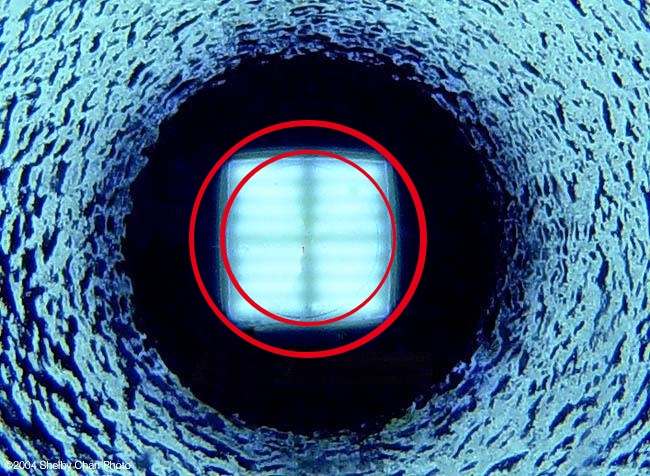GreenLED,
Below is an image that I "borrowed" from Shelby and I drew in the red circles:

It is my suspicion that the donut is a result of off axis light that comes from the 4 corners of the large image of the 5W's die. If you were to mask the center section of the die out and just project the light from the source shown inbetween the two red circles above, I believe you would get a donut or circle beam as opposed to a spot or full circle. On the other hand, if you were to mask of the image portion within the two red circles and only project the round center image, I believe you would get a conventional spot beam without the donut. When you project the full or combined image of the center and the corners, you get the combined beam which does have a greater intensity. This used to be my take on the donut but with further consideration I would like to refine this even further and give creedence back to the fact that the reflector is truly closest to colimating the image that is dead center and coincident with the major axis; namely a dead space of the cross between the four dies.
If you were to turn off three of the four dies on the 5W and and check your beam, I believe you would find a donut because the center of "mass" or intensity of the image is basically in the center of the die and this center is significantly off the major axis of the reflector. If you then were to map the beams of each of the other dies individually, you would map out three additional donuts that partially overlapped eachother but not completely. There would be a net or sum "null" in the center of the combined beams.
If you take a single die LED and reflector and allign the image and focal point and then slide the die off axis but still in the focal plane, you will get a donut after displacing the die far enough off axis. I think the 5W in most small reflectors is the case of four images all sufficiently off axis to net the null or donut. Their projections are 4 circles or donuts and not 4 spots. As the focal length of the reflector is increased, these donuts would merge with eachother as well as have their center nulls diminish in size, I believe.
I think it would be very illustrative to have a light with a red, green and blue tiny smd LED mounted in a triangle and then take this image source and apply a reflector to it.
EDIT: I have seen a slight donut with a Luxeon III (single die) in a pairing with a small and very smooth parabolic reflector. I attribute the donut in that case to both the null line between the two innermost light bars of the die as well as the fact that the image is square so there is the four corners of light that do add their collective donuts to the projection. :shrug: Ultimately, I admit to this being conjecture and supposition for the most part as I have no real empirical or theoretical experience or knowledge that would be definitive.





